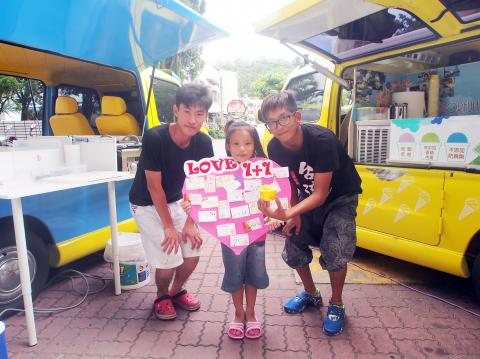Two guys, who were not originally acquainted, teamed up to contribute to society, one selling ice cream and the other selling Mexican burritos at a buy one, get one free deal. When people buy an ice cream or a burrito at their food trucks, they give one away for free to children at the next Taiwan Fund for Children and Families (TFCF) center that the food trucks stop at. Last Sunday morning, children from Taitung’s TFCF saw the playful-looking ice cream truck driving up and excitedly shouted “Thank you Mr. Ice and A-chien” and gave them self-made thank-you cards in exchange for ice-cold ice cream cups.
Kao Chien-hua works in Hsinchu and Lin Hsin-chien is a food truck entrepreneur in Taoyuan. Early in the morning on Sunday last week, Kao and Lin departed from Kenting in Pingtung and arrived at Taitung’s TFCF at around noon. They immediately parked their food trucks and prepared their ice cream and burritos for the kids.
Kao, who often travels around throwing events in his food truck, said it has been a dream for him to drive around the island. To make an island-wide trip more meaningful, he proposed the idea to his company and won strong support from his boss. He then got in touch with the nearby Hsinchu TFCF. Kao wanted to do something nice for the TFCF kids by giving away one for each ice cream he sold. In other words, he wanted to visit popular attractions and for every ice cream sold, he would give a free ice cream to the kids at the next TFCF on the journey.

Photo: Wang Hsiu-ting, Liberty Times
照片:自由時報記者王秀亭
Kao’s companion on the journey around the island, Lin, said he has wanted for a long time to use his food truck for charity, but has been unable to find a method or means. At a food truck gathering, Lin met Kao and the idea struck him that they can achieve more working together, which was when he started to drive his burrito food truck with Kao.
(Liberty Times, translated by Zane Kheir)
兩個原本不相識的人,因為想為社會做點事而湊在一起;一個賣冰淇淋、一個賣墨西哥捲餅,以買一送一的方式,民眾買一個冰淇淋或捲餅,就在下一站的家扶中心相對送出一份給學童享用。上週日上午,台東家扶中心學童看到充滿童趣的冰淇淋胖卡車到來,相當興奮,大喊「冰哥、阿賢,謝謝你!」並送上自繪感謝卡,換一杯冰涼的冰淇淋吃。
在新竹工作的高建華與在桃園以胖卡車創業的林信賢,兩人上週日清晨從屏東墾丁出發,近午抵達台東家扶中心,隨即將兩輛胖卡車就定位,準備要給小朋友享用的冰淇淋與捲餅。
常開胖卡車四處辦活動的高建華表示,環島是夢想,想讓環島更具意義,於是向公司提出這個想法,獲得老闆大力支持,就近向新竹家扶中心聯繫,想以一加一方式送愛給家扶學童,也就是環島至熱門景點,每賣出一球冰淇淋,就會在下個抵達地的家扶中心,送出所賣出的冰淇淋數量給學童享用。
陪著高建華環島的林信賢說,每月一次以胖卡車做公益的想法,存在心中已久,卻苦尋不到方法與管道;一次胖卡車聚會上,認識高建華,心想一起做的力量大,便開著墨西哥捲餅胖卡車一起參加。
(自由時報記者王秀亭)

For many people in Taiwan, childhood memories of rural life include pig pens standing beside family homes. Leftover rice, vegetable scraps and soup from daily meals were poured into buckets and fed to pigs. This practice of feeding pigs with household food waste was once a common way of life, both an economic choice and an expression of agricultural society’s deep respect for conserving resources. From a practical standpoint, pigs are omnivorous animals capable of efficiently digesting food scraps that humans can no longer eat. For rural households, food waste cost almost nothing, yet it could be converted into pork, a

Tango unfolds in a dimly lit room, where a haunting melody ushers two dancers into a close embrace. Here, music and movement merge into a silent yet passionate conversation, expressing longing, memory and shared purpose. What makes tango truly magical is the deep interaction and spontaneous improvisation between partners. Tango began in the late 19th century in Buenos Aires, Argentina’s bustling capital. Born in the poor working-class neighborhoods and busy port areas, this dance emerged from a melting pot of cultures. European immigrants, African slaves and local residents all contributed to its unique character. From these rich influences, tango

A: What show are you watching online? B: I’m watching “Fly Me to the Moon & Back” – an exhibition launched by the Taipei Music Center (TMC) to commemorate the late singer Tom Chang. A: Known for his sky-high notes, Chang is praised as one of the best singers in the 1990s. His death at the age of 31 was a major loss indeed. B: And I’m so glad that we went to the TMC’s 90s-themed concert last Friday. I finally saw the iconic “Godmother of Rock” WaWa perform live. A: This year-end show also featured singers Princess Ai, Bii, Wayne Huang, PoLin and

Continued from yesterday(延續自昨日) https://www.taipeitimes.com/News/lang The loss of sea stars significantly impacts the ocean ecosystem. Sea stars are important __6__ that help control populations of mussels and sea urchins. Among them, the sunflower star is one of the largest and fastest sea stars and is adept at preying on sea urchins. Without sea stars, sea urchins can __7__ in numbers and devastate kelp forests. These forests are essential __8__ for many marine animals and also help capture carbon from the atmosphere, which is vital in the fight against climate change. The mystery behind SSWD is still __9__, but it is clear that